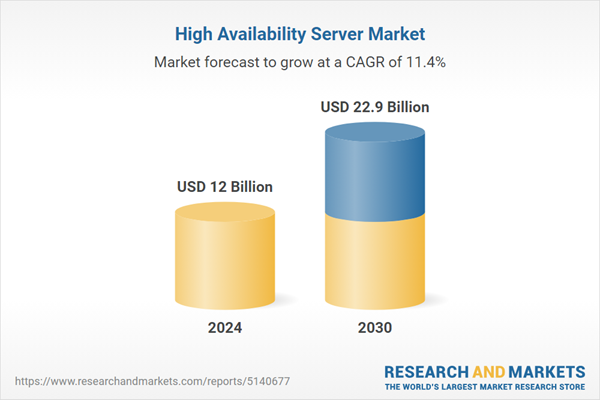Global High Availability Server Market - Key Trends & Drivers Summarized
Why Are High Availability Servers Critical for Business Continuity?
High Availability (HA) Servers have become essential for organizations requiring constant uptime and quick recovery from hardware or software failures. In today's digital economy, where downtime can mean significant revenue loss and customer dissatisfaction, HA servers are key for industries such as finance, healthcare, and e-commerce. These servers are equipped with redundancies, failover systems, and load-balancing features to ensure critical applications remain operational under any conditions. With the expansion of remote work, online services, and digital transactions, the demand for HA servers has intensified, as companies prioritize seamless operations. Especially in sectors where data accessibility and system reliability are critical, HA servers have moved from a luxury to a necessity for maintaining smooth business continuity.How Are New Technologies Enhancing the Capabilities of HA Servers?
Advances in virtualization, containerization, and cloud computing have significantly enhanced the functionality and efficiency of HA servers. Virtualization allows for better resource allocation and dynamic scalability, helping servers manage multiple applications with minimal risk of failure. Containerization further adds to efficiency, allowing applications to operate independently, reducing the chances of a complete system shutdown. Cloud-based HA solutions offer cost-effective, scalable alternatives to traditional on-premises setups, enabling companies to tailor their infrastructure to operational demands. Hybrid HA systems, integrating on-premises and cloud resources, have gained popularity for their flexibility, cost benefits, and optimized failover capabilities. Advanced monitoring tools powered by AI also contribute by identifying and addressing potential issues before they lead to failure, enabling businesses to maintain high operational standards.Why Are High Availability Servers in Demand Across Diverse Industries?
The need for reliable, uninterrupted server access has fueled the adoption of HA servers across diverse industries. The healthcare sector relies on HA servers to store and access sensitive patient data securely, ensuring data availability even in critical moments. Financial institutions prioritize HA infrastructure to support high transaction volumes and real-time trading platforms without interruptions. E-commerce platforms, which operate around the clock, depend on HA servers to avoid service disruptions that could lead to lost sales and diminished customer trust. Telecommunications companies, which must provide uninterrupted service, benefit from HA servers that support data-heavy applications and communications networks. The expanding presence of cloud-based services, IoT, and real-time applications has further driven organizations across all sectors to invest in HA servers to secure constant availability.The Growth in the High Availability Server Market Is Driven by Several Factors
The growth in the high availability server market is driven by several factors, including the increasing digitalization of industries, technological advancements in server infrastructure, and rising demand for operational continuity. As more businesses rely on digital platforms, the need for HA servers that ensure seamless operation has surged, especially with the adoption of real-time applications in fields like finance and healthcare. Technological innovations, such as cloud computing, hybrid infrastructures, and AI-powered monitoring, enable companies to scale and maintain systems with reduced costs and enhanced uptime. Additionally, rising customer expectations for uninterrupted service across sectors such as e-commerce and telecommunications have made HA servers indispensable, leading companies to prioritize investment in HA solutions that support scalability, flexibility, and reliability.Report Scope
The report analyzes the High Availability Server market, presented in terms of market value (US$ Thousand). The analysis covers the key segments and geographic regions outlined below.- Segments: Operating System (Linux, Windows, Other Operating Systems); End-Use (BFSI, IT & Telecom, Retail, Medical & Healthcare, Manufacturing, Government, Other End-Uses).
- Geographic Regions/Countries:World; United States; Canada; Japan; China; Europe (France; Germany; Italy; United Kingdom; and Rest of Europe); Asia-Pacific; Rest of World.
Key Insights:
- Market Growth: Understand the significant growth trajectory of the Linux Operating System segment, which is expected to reach US$11.9 Billion by 2030 with a CAGR of a 11.9%. The Windows Operating System segment is also set to grow at 11% CAGR over the analysis period.
- Regional Analysis: Gain insights into the U.S. market, valued at $3.3 Billion in 2024, and China, forecasted to grow at an impressive 10.3% CAGR to reach $3.4 Billion by 2030. Discover growth trends in other key regions, including Japan, Canada, Germany, and the Asia-Pacific.
Why You Should Buy This Report:
- Detailed Market Analysis: Access a thorough analysis of the Global High Availability Server Market, covering all major geographic regions and market segments.
- Competitive Insights: Get an overview of the competitive landscape, including the market presence of major players across different geographies.
- Future Trends and Drivers: Understand the key trends and drivers shaping the future of the Global High Availability Server Market.
- Actionable Insights: Benefit from actionable insights that can help you identify new revenue opportunities and make strategic business decisions.
Key Questions Answered:
- How is the Global High Availability Server Market expected to evolve by 2030?
- What are the main drivers and restraints affecting the market?
- Which market segments will grow the most over the forecast period?
- How will market shares for different regions and segments change by 2030?
- Who are the leading players in the market, and what are their prospects?
Report Features:
- Comprehensive Market Data: Independent analysis of annual sales and market forecasts in US$ Million from 2024 to 2030.
- In-Depth Regional Analysis: Detailed insights into key markets, including the U.S., China, Japan, Canada, Europe, Asia-Pacific, Latin America, Middle East, and Africa.
- Company Profiles: Coverage of players such as CenterServ International, Cisco Systems, Inc., Dell Technologies, Inc., Fujitsu Ltd., Hewlett Packard Enterprise Development LP (HPE) and more.
- Complimentary Updates: Receive free report updates for one year to keep you informed of the latest market developments.
Some of the 38 companies featured in this High Availability Server market report include:
- CenterServ International
- Cisco Systems, Inc.
- Dell Technologies, Inc.
- Fujitsu Ltd.
- Hewlett Packard Enterprise Development LP (HPE)
- Huawei Technologies Co., Ltd.
- IBM Corporation
- Juniper Networks, Inc.
- NEC Corporation of America
- Oracle Corporation
This edition integrates the latest global trade and economic shifts into comprehensive market analysis. Key updates include:
- Tariff and Trade Impact: Insights into global tariff negotiations across 180+ countries, with analysis of supply chain turbulence, sourcing disruptions, and geographic realignment. Special focus on 2025 as a pivotal year for trade tensions, including updated perspectives on the Trump-era tariffs.
- Adjusted Forecasts and Analytics: Revised global and regional market forecasts through 2030, incorporating tariff effects, economic uncertainty, and structural changes in globalization. Includes historical analysis from 2015 to 2023.
- Strategic Market Dynamics: Evaluation of revised market prospects, regional outlooks, and key economic indicators such as population and urbanization trends.
- Innovation & Technology Trends: Latest developments in product and process innovation, emerging technologies, and key industry drivers shaping the competitive landscape.
- Competitive Intelligence: Updated global market share estimates for 2025, competitive positioning of major players (Strong/Active/Niche/Trivial), and refined focus on leading global brands and core players.
- Expert Insight & Commentary: Strategic analysis from economists, trade experts, and domain specialists to contextualize market shifts and identify emerging opportunities.
Table of Contents
Companies Mentioned (Partial List)
A selection of companies mentioned in this report includes, but is not limited to:
- CenterServ International
- Cisco Systems, Inc.
- Dell Technologies, Inc.
- Fujitsu Ltd.
- Hewlett Packard Enterprise Development LP (HPE)
- Huawei Technologies Co., Ltd.
- IBM Corporation
- Juniper Networks, Inc.
- NEC Corporation of America
- Oracle Corporation
Table Information
| Report Attribute | Details |
|---|---|
| No. of Pages | 192 |
| Published | December 2025 |
| Forecast Period | 2024 - 2030 |
| Estimated Market Value ( USD | $ 12 Billion |
| Forecasted Market Value ( USD | $ 22.9 Billion |
| Compound Annual Growth Rate | 11.4% |
| Regions Covered | Global |









